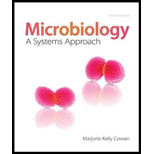
Microbiology: A Systems Approach
4th Edition
ISBN: 9780073402437
Author: Marjorie Kelly Cowan Professor
Publisher: McGraw-Hill Education
expand_more
expand_more
format_list_bulleted
Question
Chapter 17.3, Problem 14AYP
Summary Introduction
To compare:
Precipitation with agglutination with one example of each used in disease diagnosis.
Concept introduction:
Agglutination is a process when an antigen binds to an antibody and clumping occurs. The antibody to which the antigen binds is termed as isoagglutinin. This process is majorly used to determine blood group.
Expert Solution & Answer
Want to see the full answer?
Check out a sample textbook solution
Students have asked these similar questions
What is the structure and function of Eukaryotic cells, including their organelles? How are Eukaryotic cells different than Prokaryotic cells, in terms of evolution which form of the cell might have came first? How do Eukaryotic cells become malignant (cancerous)?
What are the roles of DNA and proteins inside of the cell? What are the building blocks or molecular components of the DNA and proteins? How are proteins produced within the cell? What connection is there between DNA, proteins, and the cell cycle? What is the relationship between DNA, proteins, and Cancer?
Why cells go through various types of cell division and how eukaryotic cells control cell growth through the cell cycle control system?
Chapter 17 Solutions
Microbiology: A Systems Approach
Ch. 17.1 - Prob. 1AYPCh. 17.1 - Prob. 2AYPCh. 17.1 - Prob. 3AYPCh. 17.1 - Prob. 4AYPCh. 17.2 - Summarize the most common methods used for direct...Ch. 17.2 - Prob. 6AYPCh. 17.2 - Prob. 7AYPCh. 17.3 - Prob. 2CFCh. 17.3 - Prob. 8AYPCh. 17.3 - Prob. 9AYP
Ch. 17.3 - Prob. 10AYPCh. 17.3 - Prob. 11AYPCh. 17.3 - Differentiate between sensitivity and specificity.Ch. 17.3 - Explain how fluorescent antibodies can be used in...Ch. 17.3 - Prob. 14AYPCh. 17.4 - Prob. 15AYPCh. 17.4 - Prob. 16AYPCh. 17.4 - Prob. 17AYPCh. 17.5 - Prob. 18AYPCh. 17.5 - List the major advantages of microarray methods of...Ch. 17.5 - Summarize the benefits of using whole-genome...Ch. 17.5 - Prob. 21AYPCh. 17 - Prob. 1CFCh. 17 - Prob. 1MCQCh. 17 - Prob. 2MCQCh. 17 - Prob. 3MCQCh. 17 - Prob. 4MCQCh. 17 - Prob. 5MCQCh. 17 - Prob. 6MCQCh. 17 - Prob. 7MCQCh. 17 - Prob. 8MCQCh. 17 - The Western blot test can be used to identify a....Ch. 17 - Prob. 10MCQCh. 17 - True-False Questions. If the statement is true,...Ch. 17 - Prob. 12TFCh. 17 - Prob. 13TFCh. 17 - Prob. 14TFCh. 17 - Prob. 15TFCh. 17 - Explain why specimens should be taken aseptically,...Ch. 17 - Prob. 2CTQCh. 17 - Prob. 3CTQCh. 17 - Prob. 4CTQCh. 17 - Prob. 5CTQCh. 17 - Prob. 6CTQCh. 17 - Prob. 7CTQCh. 17 - Prob. 8CTQCh. 17 - Prob. 9CTQCh. 17 - Prob. 10CTQCh. 17 - Prob. 1CCCh. 17 - Prob. 2CCCh. 17 - Prob. 3CCCh. 17 - Prob. 4CCCh. 17 - Prob. 1VCCh. 17 - Prob. 2VCCh. 17 - Prob. 1CM
Knowledge Booster
Similar questions
- In one paragraph show how atoms and they're structure are related to the structure of dna and proteins. Talk about what atoms are. what they're made of, why chemical bonding is important to DNA?arrow_forwardWhat are the structure and properties of atoms and chemical bonds (especially how they relate to DNA and proteins).arrow_forwardThe Sentinel Cell: Nature’s Answer to Cancer?arrow_forward
- Molecular Biology Question You are working to characterize a novel protein in mice. Analysis shows that high levels of the primary transcript that codes for this protein are found in tissue from the brain, muscle, liver, and pancreas. However, an antibody that recognizes the C-terminal portion of the protein indicates that the protein is present in brain, muscle, and liver, but not in the pancreas. What is the most likely explanation for this result?arrow_forwardMolecular Biology Explain/discuss how “slow stop” and “quick/fast stop” mutants wereused to identify different protein involved in DNA replication in E. coli.arrow_forwardMolecular Biology Question A gene that codes for a protein was removed from a eukaryotic cell and inserted into a prokaryotic cell. Although the gene was successfully transcribed and translated, it produced a different protein than it produced in the eukaryotic cell. What is the most likely explanation?arrow_forward
- Molecular Biology LIST three characteristics of origins of replicationarrow_forwardMolecular Biology Question Please help. Thank you For E coli DNA polymerase III, give the structure and function of the b-clamp sub-complex. Describe how the structure of this sub-complex is important for it’s function.arrow_forwardMolecular Biology LIST three characteristics of DNA Polymerasesarrow_forward
arrow_back_ios
SEE MORE QUESTIONS
arrow_forward_ios
Recommended textbooks for you
 Principles Of Radiographic Imaging: An Art And A ...Health & NutritionISBN:9781337711067Author:Richard R. Carlton, Arlene M. Adler, Vesna BalacPublisher:Cengage Learning
Principles Of Radiographic Imaging: An Art And A ...Health & NutritionISBN:9781337711067Author:Richard R. Carlton, Arlene M. Adler, Vesna BalacPublisher:Cengage Learning Comprehensive Medical Assisting: Administrative a...NursingISBN:9781305964792Author:Wilburta Q. Lindh, Carol D. Tamparo, Barbara M. Dahl, Julie Morris, Cindy CorreaPublisher:Cengage Learning
Comprehensive Medical Assisting: Administrative a...NursingISBN:9781305964792Author:Wilburta Q. Lindh, Carol D. Tamparo, Barbara M. Dahl, Julie Morris, Cindy CorreaPublisher:Cengage Learning- Surgical Tech For Surgical Tech Pos CareHealth & NutritionISBN:9781337648868Author:AssociationPublisher:Cengage


Principles Of Radiographic Imaging: An Art And A ...
Health & Nutrition
ISBN:9781337711067
Author:Richard R. Carlton, Arlene M. Adler, Vesna Balac
Publisher:Cengage Learning

Comprehensive Medical Assisting: Administrative a...
Nursing
ISBN:9781305964792
Author:Wilburta Q. Lindh, Carol D. Tamparo, Barbara M. Dahl, Julie Morris, Cindy Correa
Publisher:Cengage Learning



Surgical Tech For Surgical Tech Pos Care
Health & Nutrition
ISBN:9781337648868
Author:Association
Publisher:Cengage